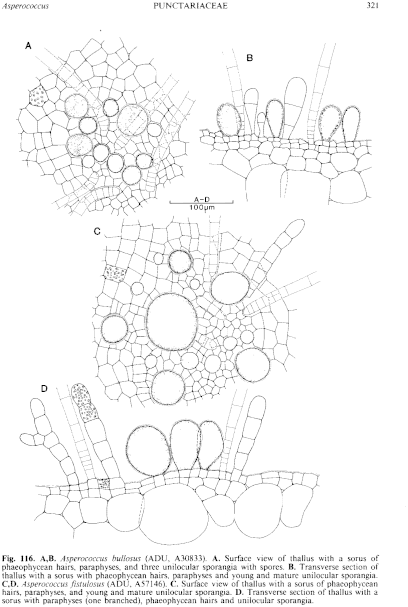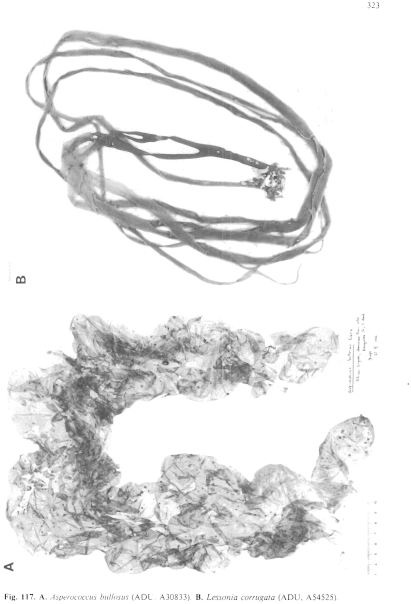|
|
|
|
|
|||||||||||
|
Electronic Flora of South Australia Species Fact Sheet
Phylum Phaeophyta – Order Dictyosiphonales – Family Punctariaceae
Selected citations: Hamel 1937: 223. Knight et al. 1935: 91. Kylin 1947: 75, fig. 60E,F, pl. 11 fig. 38. Lindauer et al. 1961: 260, pl. 4. Rosenvinge & Lund 1947: 41, fig. 14. Womersley 1967: 243.
Synonyms
Ulva turneri Dillwyn in Smith & Sowerby 1813, pl. 2570.
Asperococcus turneri (Dillwyn in Smith & Sowerby) Hooker 1833: 277. Clayton 1982: 114. Harvey 1846: pl. 11.
Thallus (Fig. 114C, 1 17A) medium to dark brown, membranous, hollow and irregularly inflated to bullose, (3–) 10–70 (–100) cm long and (1–) 2–8 (–12) cm in diameter, with a small holdfast 0.5–2 mm across, and a short, slender stipe 2–10 mm long, expanding suddenly to the inflated thallus; usually epiphytic on Posidonia. Structure of membrane (Fig. 116A,B) 120–240 (–300) µm and 3–5 cells thick, with a cortex of small phaeoplastic cells, several overlying each of the larger medullary cells; cortical cells more or less in rows, angular, isodiametric, 20–35 µm across in surface view (Fig. 116A), each with several discoid phaeoplasts with 1–2 pyrenoids. Phaeophycean hairs single or in small groups, 16–20 µm in diameter.
Microthallus (unknown in Australia) filamentous, branched.
Reproduction: Sori (Fig. 116A,B) of sporangia rounded to elongate, scattered moderately densely, 100–350 µm across, containing sessile, pyriform to clavate, unilocular sporangia 30–40 µm long and 20–30 µm in diameter, and sessile, ovoid, plurilocular sporangia (usually in the same sorus) 40–60 µm long and 30–40 µm in diameter, together with a few phaeophycean hairs and clavate paraphyses 2 (–4) cells long, the end cell 20–25 µm in diameter with dense physodes.
Microthalli with plurilocular gametangia producing isogametes (Knight et al. 1935, p. 93, fig. 1); or reproducing the macrothallus directly (Clayton 1982, p. 114) from zooids from unilocular sporangia.
Type from "Medit. Gall."; in Herb. Lamouroux, CN.
Selected specimens: Green I. Bay, Rottnest I., W. Aust., on Posidonia sinuosa, drift (Farsons, 7.xii.1984; ADU, A56299). Frenchman Bay, Albany, W. Aust., on P. sinuosa, drift (Parsons, 18.xi.1968; ADU, A33232). Pearson I., S. Aust., on P. angustifolia, 20 m deep (Carrodus, 18.ii.1960; ADU, A24500). Coffin Bay, S. Aust., on P. sinuosa, 3–4 m deep (Womersley, 4.xii.1975; ADU, A46933). N. Spencer Gulf, S. Aust., on P. australis and Amphibolis antarctica, 0–1 m deep (Shepherd, 4.ix.1973; ADU, A44095, A44096 resp.) American R. inlet, Kangaroo I., S. Aust., on P. australis, upper sublittoral ( Womersley, 26.viii.1948; ADU, A8689). Pelican Lagoon, American R. inlet, S. Aust., drift ( Womersley, 27.x.1966; ADU, A30833). Crawfish Rock, Westernport Bay, Vic., on Heterozostera, upper sublittoral (Kraft & Min Thein, 24.viii.1971; ADU, A39357-"Marine Algae of southern Australia" No. 49). Low Head, Tas. (Crosby, 9.xii.1934; ADU, A50103). Eden, N.S.W. (Lucas, Jan. 1910; NSW). Pittwater, N.S.W. (Harada, 22.x.1975; NSW).
Distribution: Widely distributed in temperate seas.
In southern Australia, from Rottnest I., W. Aust. (probably further north) to Pittwater, N.S.W., and the north and east coasts of Tasmania, epiphytic on Posidonia and Amphibolis usually in shallow, sheltered waters but extending to 22 m deep.
Taxonomic notes: Both A. bullosus and A. turneri have been recognised as names for this species, the former on the Continent and the latter in Britain. According to Stafleu & Cowan (1979, p. 741), A. bullosus Lamouroux (1813) was published in August that year, and Ulva turneri Dillwyn in Smith & Sowerby has the plate dated Nov. 1, 1813, with the volume published between 1 March 1813 (pl. 2521) and 1 March 1814 (pl. 2592). A. bullosus clearly has priority. The plate of Ulva turneri may include both A. bullosus (on the left) and A. fistulosus (on the right).
References:
CLAYTON, M.N. (1982). Life history studies in the Ectocarpales (Phaeophyta): Contributions toward the understanding of evolutionary processes. Bot. Mar. 25, 111–116.
HAMEL, G. (1937). Phéophycées de France. Fasc. III, pp. 177–240. (Paris.)
HARVEY, W.H. (1846). Phycologia Britannica. Plates 1–72. (Reeve: London.)
HOOKER, W.J. (1833). The British Flora. 4th Edn, Vol. 2: Cryptogamia. (Longman: London.)
KNIGHT, M., BLACKLER, M.C.H. & PARKE, M.W. (1935). Notes on the life-cycle of species of Asperococcus. Proc. Trans. Liverpool Biol. Soc. 48, 79–97.
KYLIN, H. (1947). Die Phaeophyceen der Schwedischen Westkiiste. Acta Univ. lund. N.F. Avd. 2, 43(4), 1–99, Plates 1–18.
LAMOUROUX, J.V.F. (1813). Essai sur les genres de la famille des thalassiophytes non articulées. Ann. Mus. Hist. Nat., Paris 20, 21–47, 115–139, 267–293, Plates 7–13(1–7).
LINDAUER, V.W., CHAPMAN, V.J. & AIKEN, M. (1961). The marine algae of New Zealand. II. Phaeophyceae. Nova Hedwigia 3, 129–350, Plates 57–97.
ROSENVINGE, L.K. & LUND, S. (1947). The marine algae of Denmark. Vol. II. Phaeophyceae. III. Encoeliaceae, Myriotrichiaceae, Giraudiaceae, Striariaceae, Dictyosiphonaceae, Chordaceae and Laminariaceae. K. Dan. Vidensk. Selsk. Biol. Skr. 4(5), 1–99.
SMITH, J.E. & SOWERBY, J. (1813). English Botany. Edn 1, Vol. 36, Plates 2521–2592. (London.)
STAFLEU, F.A. & COWAN, R.S. (1979). Taxonomic Literature. 2nd Edn, Vol. II, H-Le. Regnum Veg. 98, 1–991.
WOMERSLEY, H.B.S. (1967). A critical survey of the marine algae of southern Australia. II. Phaeophyta. Aust. J. Bot. 15, 189–270.
The Marine Benthic Flora of Southern Australia Part II complete list of references.
Publication:
Womersley, H.B.S. (14 December, 1987)
The Marine Benthic Flora of Southern Australia
Part II
©Board of the Botanic Gardens and State Herbarium, Government of South Australia
Illustrations in Womersley Part II, 1997: FIGS 114C, 116A,B, 117A.

Figure 114 enlarge
Fig. 114. A. Punctaria latifolia (ADU, A54509). B. Asperococcus compressus (ADU, A57205). C. Asperococcus bullosus (ADU, A56299). D. Asperococcus fistulosus (ADU, A57146).

Figure 116 enlarge
Fig. 116. A,B. Asperococcus bullosus (ADU, A30833). A. Surface view of thallus with a sorus of phaeophycean hairs, paraphyses, and three unilocular sporangia with spores. B. Transverse section of thallus with a sorus with phaeophycean hairs, paraphyses and young and mature unilocular sporangia. C,D. Asperococcus fistulosus (ADU, A57146). C. Surface view of thallus with a sorus of phaeophycean hairs, paraphyses, and young and mature unilocular sporangia. D. Transverse section of thallus with a sorus with paraphyses (one branched), phaeophycean hairs and unilocular sporangia.

Figure 117 enlarge
Fig. 117. A. Asperococcus bullosus (ADU, A30833). B. Lessonia corrugata (ADU, A54525).

|
Email Contact: State Herbarium of South Australia |

|